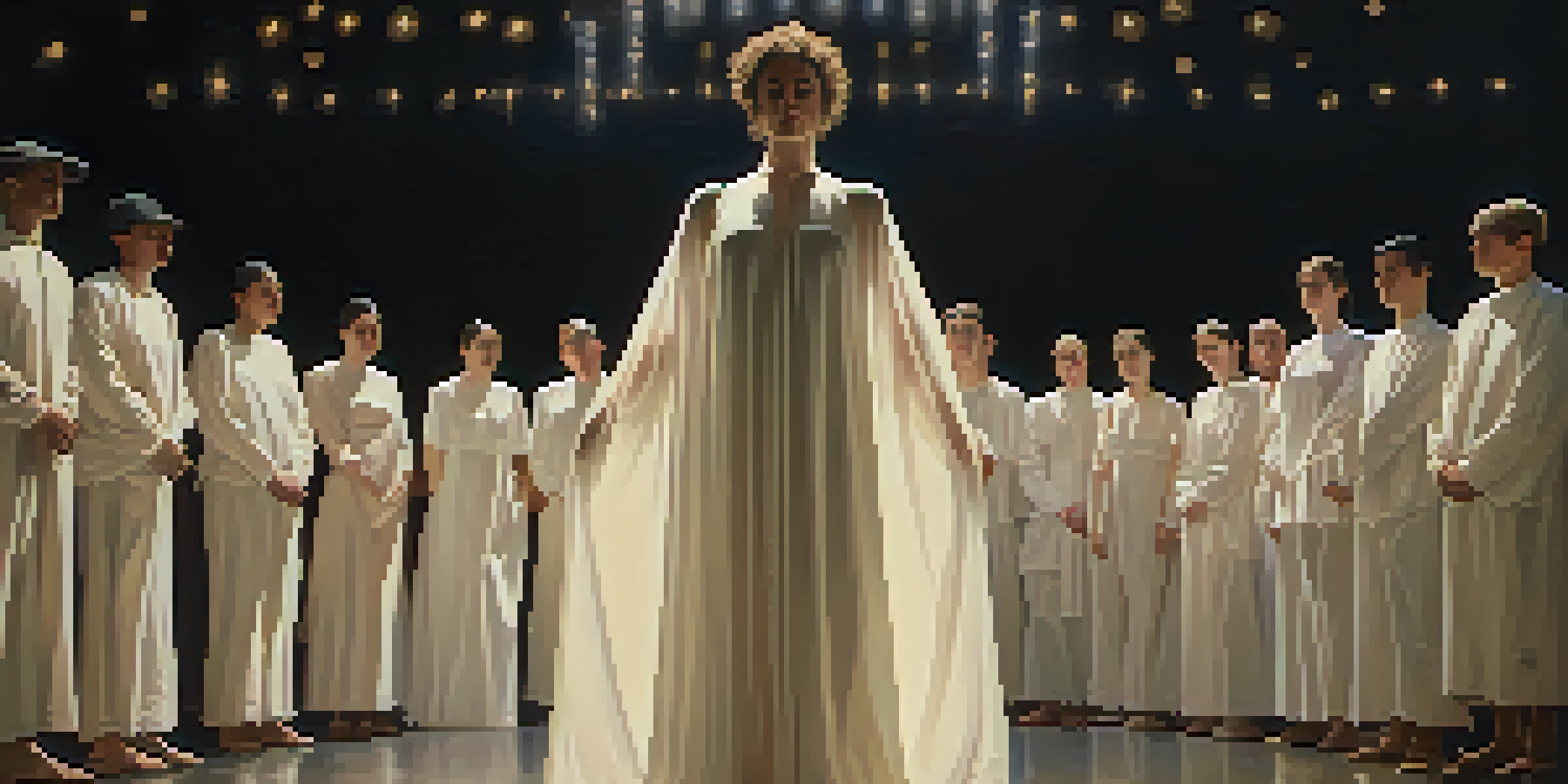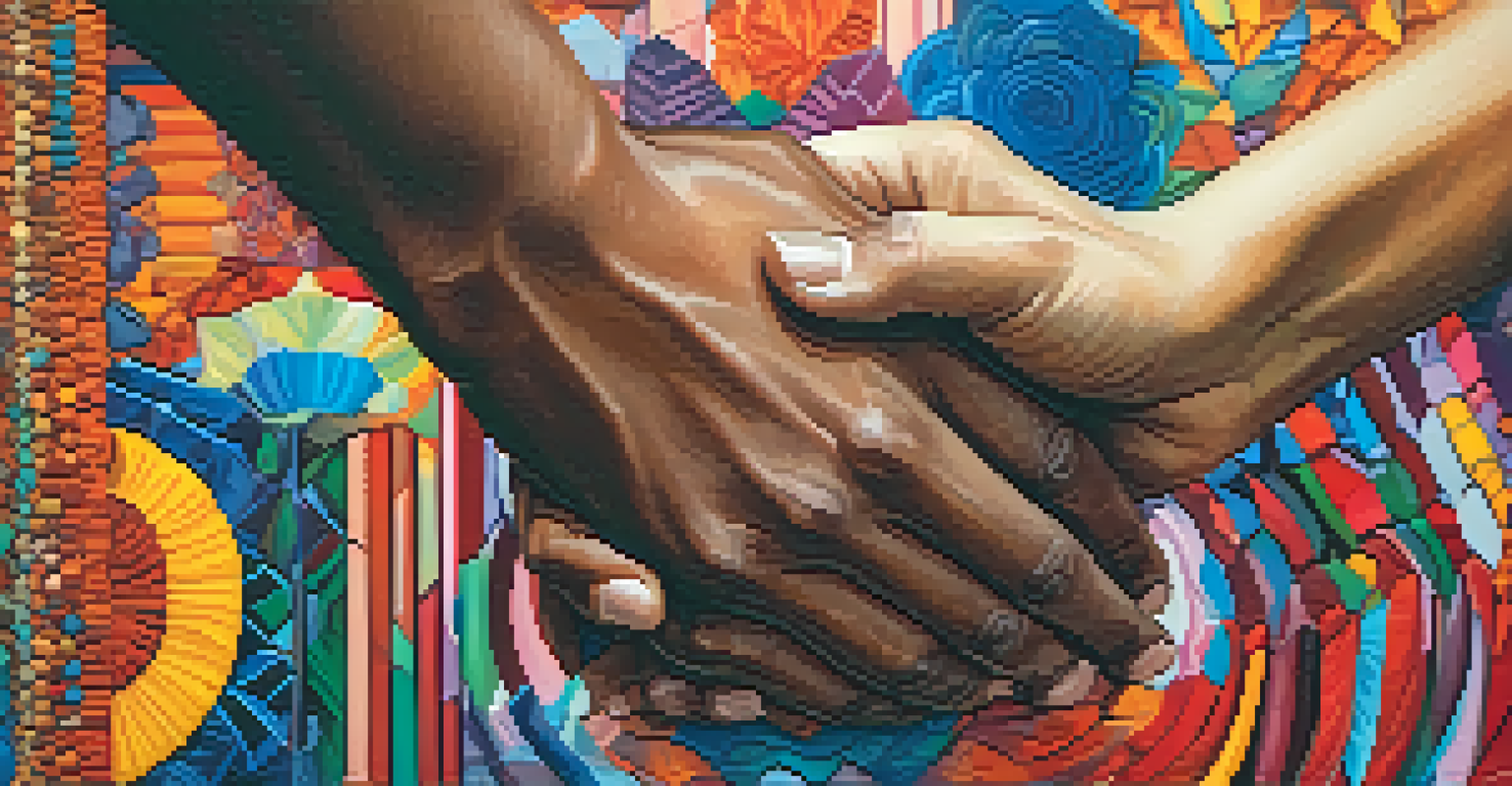The Ethics of Performance Art: Boundaries and Responsibilities

Understanding Performance Art and Its Impact
Performance art is a unique medium that combines various art forms, often blurring the lines between artist and audience. Unlike traditional art, where the viewer remains a passive observer, performance art invites active participation and stimulates emotional responses. This interactivity can lead to profound experiences, but it also raises ethical questions about the responsibilities of the artist and the viewer.
Art is not a mirror to reflect the world, but a hammer with which to shape it.
The impact of performance art can be both powerful and controversial, sometimes provoking strong reactions. For instance, artists may tackle difficult social issues, pushing boundaries to challenge societal norms. While this can spark important conversations, it also raises the question: how far is too far when it comes to provoking an audience?
Ultimately, understanding the essence of performance art is crucial in discussing its ethics. The artist’s intention, the audience’s reception, and the context in which the performance takes place all play significant roles in determining the ethical implications of the work.
The Role of Consent in Performance Art
Consent is a cornerstone in any ethical discussion, especially in performance art. Artists must ensure that participants, whether they are volunteers or audience members, are fully informed and agree to take part in the performance. This concept extends beyond mere verbal agreements; it encompasses emotional and psychological readiness as well.

For example, consider a performance that involves physical touch or emotional manipulation. If participants feel uncomfortable or coerced, the integrity of the artwork is compromised, and ethical boundaries are crossed. Thus, transparent communication is vital to foster a safe environment where individuals can engage without fear of exploitation.
Ethics of Consent in Performance Art
Consent is crucial for ensuring that all participants are fully informed and comfortable, fostering a safe environment for engagement.
In this realm, artists must navigate the delicate balance between artistic freedom and the responsibility toward their participants. Establishing clear guidelines and open discussions can help mitigate potential ethical dilemmas, ensuring that everyone involved is on the same page.
Cultural Sensitivity and Representation
Cultural sensitivity plays a significant role in performance art, particularly when artists draw inspiration from cultures other than their own. This practice, known as cultural appropriation, can lead to ethical concerns, especially if the representation is superficial or disrespectful. Artists must be aware of the cultural narratives they are engaging with and approach them with respect and understanding.
The artist is a social being, and his work is a social act. He must know how to reach the audience and how to engage them.
An example of this can be seen in performances that utilize traditional rituals or symbols from marginalized communities. If the artist lacks a genuine connection to the culture they are representing, it may come across as exploitative rather than celebratory. Therefore, artists should strive for authenticity and seek to collaborate with cultural representatives when appropriate.
By fostering relationships and engaging in dialogue with the communities they represent, artists can create more meaningful and respectful performances. This not only enhances the work’s depth but also honors the rich traditions and stories behind the art.
The Impact of Audience Interpretation
Audience interpretation can greatly influence the ethical landscape of performance art. Once a performance concludes, the artist loses control over how their work is perceived and understood. This can lead to a range of interpretations, some of which may diverge significantly from the artist's original intent, raising questions about accountability.
For instance, a performance intended to critique societal norms may be interpreted as reinforcing those same norms by certain audience members. This disconnect can create ethical dilemmas, as the artist must grapple with the implications of their work being misinterpreted or misused. It's essential for artists to consider potential interpretations and their responsibilities in guiding the audience's understanding.
Cultural Sensitivity in Representation
Artists must approach cultural narratives with respect to avoid appropriation and ensure authentic representation.
Encouraging open dialogue and providing context for their work can help mitigate these challenges. By fostering a space for discussion, artists can clarify their intentions and invite audiences to engage with the performance on a deeper level.
Navigating Personal Boundaries in Performance Art
Artists often push their personal boundaries in performance art, which can lead to transformative experiences. However, this self-exploration also raises ethical questions about the limits of vulnerability and the potential impact on both the artist and the audience. It's crucial for artists to establish their personal boundaries before embarking on a performance journey.
For example, an artist may decide to share deeply personal experiences, such as trauma or loss, as part of their performance. While this can create a powerful connection with the audience, it also exposes the artist to emotional risks. Maintaining a balance between authenticity and self-protection is vital to ensure that the performance remains a healthy expression rather than a harmful experience.
Creating a supportive environment, both for themselves and their audience, can help artists navigate these challenges. Setting clear boundaries allows for a deeper exploration of personal themes while minimizing potential harm.
The Duty of Artists as Social Commentators
Performance artists often find themselves in the role of social commentators, using their work to address pressing societal issues. This responsibility can be both empowering and daunting, as artists must consider how their performances contribute to the broader conversation. The ethical implications of their messages can shape public perception and influence change.
For instance, an artist might tackle themes like systemic injustice or environmental crises, aiming to raise awareness and inspire action. However, they must also recognize the weight of their words and actions, ensuring that their performances do not perpetuate harm or misinformation. This awareness is crucial in maintaining credibility and fostering positive dialogue.
Audience Interpretation Shapes Ethics
The way audiences interpret performances can create ethical dilemmas, highlighting the importance of clear communication and context.
By approaching their work with a sense of duty and responsibility, artists can create lasting impact while navigating the ethical complexities inherent in social commentary. Engaging with their audience and encouraging reflection can amplify the effectiveness of their messages.
The Future of Ethical Performance Art
As performance art continues to evolve, the conversation around ethics will remain vital. With the rise of digital platforms and virtual performances, artists are challenged to rethink boundaries and responsibilities in new contexts. This evolution opens up opportunities for innovation but also requires a careful examination of ethical considerations.
For example, online performances can reach a wider audience but may lack the immediacy and intimacy of live events. Artists must consider how to engage their audience meaningfully in a virtual space while maintaining ethical standards. Ensuring that the essence of performance art is preserved in these new formats is crucial.

Ultimately, the future of ethical performance art will depend on ongoing dialogue between artists, audiences, and communities. By actively engaging with these conversations, the art form can continue to grow while addressing the complexities of ethics in a changing world.